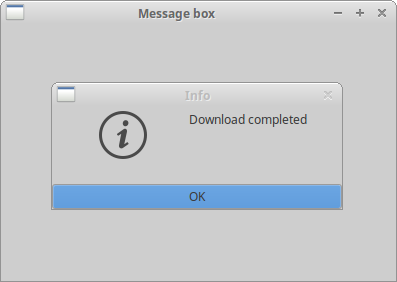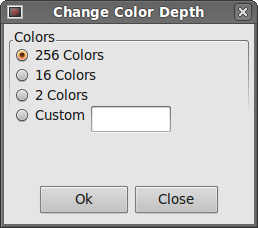wxPython dialogs
Dialog windows or dialogs are an indispensable part of most modern GUI applications. A dialog is defined as a conversation between two or more persons. In a computer application a dialog is a window which is used to "talk" to the application. A dialog is used to input data, modify data, change the application settings etc. Dialogs are important means of communication between a user and a computer program.A Simple message box
A message box provides short information to the user. A good example is a cd burning application. When a cd is finished burning, a message box pops up.#!/usr/bin/pythonThis example shows a message box after 5 seconds.
# -*- coding: utf-8 -*-
'''
ZetCode wxPython tutorial
This example shows a simple
message box.
author: Jan Bodnar
website: www.zetcode.com
last modified: October 2011
'''
import wx
class Example(wx.Frame):
def __init__(self, *args, **kwargs):
super(Example, self).__init__(*args, **kwargs)
self.InitUI()
def InitUI(self):
wx.FutureCall(5000, self.ShowMessage)
self.SetSize((300, 200))
self.SetTitle('Message box')
self.Centre()
self.Show(True)
def ShowMessage(self):
wx.MessageBox('Download completed', 'Info',
wx.OK | wx.ICON_INFORMATION)
def main():
ex = wx.App()
Example(None)
ex.MainLoop()
if __name__ == '__main__':
main()
wx.FutureCall(5000, self.ShowMessage)
wx.FutureCall calls a method after 5 seconds. The first parameter is a time value, after which a given method is called. The parameter is in milliseconds. The second parameter is a method to be called. def ShowMessage(self):
wx.MessageBox('Download completed', 'Info',
wx.OK | wx.ICON_INFORMATION)
wx.MessageBox shows a small dialog window. We provide three parameters. The text message, the title message and flags. The flags are used to show different buttons and icons. In our case we show an OK button and Information icon. 
Figure: A Message box
Predefined dialogs
wxPython has several predefined dialogs. These are dialogs for common programming tasks like showing text, receiving input, loading and saving files etc.Message dialogs
Message dialogs are used to show messages to the user. They are more flexible than simple message boxes, that we saw in the previous example. They are customizable. We can change icons and buttons that will be shown in a dialog.| flag | meaning |
|---|---|
| wx.OK | show Ok button |
| wx.CANCEL | show Cancel button |
| wx.YES_NO | show Yes, No buttons |
| wx.YES_DEFAULT | make Yes button the default |
| wx.NO_DEFAULT | make No button the default |
| wx.ICON_EXCLAMATION | show an alert icon |
| wx.ICON_ERROR | show an error icon |
| wx.ICON_HAND | same as wx.ICON_ERROR |
| wx.ICON_INFORMATION | show an info icon |
| wx.ICON_QUESTION | show a question icon |
wx.MessageDialog class. #!/usr/bin/pythonIn our example, we have created four buttons and put them in a grid sizer. These buttons will show four different dialog windows. We create them by specifying different style flags.
# -*- coding: utf-8 -*-
'''
ZetCode wxPython tutorial
This example shows four types of
message dialogs.
author: Jan Bodnar
website: www.zetcode.com
last modified: October 2011
'''
import wx
class Example(wx.Frame):
def __init__(self, *args, **kwargs):
super(Example, self).__init__(*args, **kwargs)
self.InitUI()
def InitUI(self):
panel = wx.Panel(self)
hbox = wx.BoxSizer()
sizer = wx.GridSizer(2, 2, 2, 2)
btn1 = wx.Button(panel, label='Info')
btn2 = wx.Button(panel, label='Error')
btn3 = wx.Button(panel, label='Question')
btn4 = wx.Button(panel, label='Alert')
sizer.AddMany([btn1, btn2, btn3, btn4])
hbox.Add(sizer, 0, wx.ALL, 15)
panel.SetSizer(hbox)
btn1.Bind(wx.EVT_BUTTON, self.ShowMessage1)
btn2.Bind(wx.EVT_BUTTON, self.ShowMessage2)
btn3.Bind(wx.EVT_BUTTON, self.ShowMessage3)
btn4.Bind(wx.EVT_BUTTON, self.ShowMessage4)
self.SetSize((300, 200))
self.SetTitle('Messages')
self.Centre()
self.Show(True)
def ShowMessage1(self, event):
dial = wx.MessageDialog(None, 'Download completed', 'Info', wx.OK)
dial.ShowModal()
def ShowMessage2(self, event):
dial = wx.MessageDialog(None, 'Error loading file', 'Error',
wx.OK | wx.ICON_ERROR)
dial.ShowModal()
def ShowMessage3(self, event):
dial = wx.MessageDialog(None, 'Are you sure to quit?', 'Question',
wx.YES_NO | wx.NO_DEFAULT | wx.ICON_QUESTION)
dial.ShowModal()
def ShowMessage4(self, event):
dial = wx.MessageDialog(None, 'Unallowed operation', 'Exclamation',
wx.OK | wx.ICON_EXCLAMATION)
dial.ShowModal()
def main():
ex = wx.App()
Example(None)
ex.MainLoop()
if __name__ == '__main__':
main()
def ShowMessage2(self, event):The creation of the message dialog is simple. We set the dialog to be a toplevel window by providing None as a parent. The two strings provide the message text and the dialog title. We show an OK button and an error icon by specifying the
dial = wx.MessageDialog(None, 'Error loading file', 'Error',
wx.OK | wx.ICON_ERROR)
dial.ShowModal()
wx.OK and wx.ICON_ERROR flags. To show the dialog on screen, we call the ShowModal() method. 
Information dialog
About dialog box
Almost every application has a typical about dialog box. It is usually placed in the Help menu. The purpose of this dialog is to give the user the basic information about the name and the version of the application. In the past, these dialogs used to be quite brief. These days most of these boxes provide additional information about the authors. They give credits to additional programmers or documentation writers. They also provide information about the application licence. These boxes can show the logo of the company or the application logo. Some of the more capable about boxes show animation. wxPython has a special about dialog box starting from 2.8.x series.In order to create an about dialog box we must create two objects. A
wx.AboutDialogInfo and a wx.AboutBox. wxPython can display two kinds of About boxes. It depends on which platform we use and which methods we call. It can be a native dialog or a wxPython generic dialog. Windows native about dialog box cannot display custom icons, licence text nor the url's. If we omit these three fields, wxPython will show a native dialog. Otherwise it will resort to a generic one. It is advised to provide licence information in a separate menu item, if we want to stay as native as possible. GTK+ can show all these fields.
#!/usr/bin/pythonThe example has an about menu item. After selecting the item, the about box is displayed.
# -*- coding: utf-8 -*-
'''
ZetCode wxPython tutorial
In this example, we create an
about dialog box.
author: Jan Bodnar
website: www.zetcode.com
last modified: October 2011
'''
import wx
class Example(wx.Frame):
def __init__(self, *args, **kwargs):
super(Example, self).__init__(*args, **kwargs)
self.InitUI()
def InitUI(self):
menubar = wx.MenuBar()
help = wx.Menu()
help.Append(100, '&About')
self.Bind(wx.EVT_MENU, self.OnAboutBox, id=100)
menubar.Append(help, '&Help')
self.SetMenuBar(menubar)
self.SetSize((300, 200))
self.SetTitle('About dialog box')
self.Centre()
self.Show(True)
def OnAboutBox(self, e):
description = """File Hunter is an advanced file manager for
the Unix operating system. Features include powerful built-in editor,
advanced search capabilities, powerful batch renaming, file comparison,
extensive archive handling and more.
"""
licence = """File Hunter is free software; you can redistribute
it and/or modify it under the terms of the GNU General Public License as
published by the Free Software Foundation; either version 2 of the License,
or (at your option) any later version.
File Hunter is distributed in the hope that it will be useful,
but WITHOUT ANY WARRANTY; without even the implied warranty of
MERCHANTABILITY or FITNESS FOR A PARTICULAR PURPOSE.
See the GNU General Public License for more details. You should have
received a copy of the GNU General Public License along with File Hunter;
if not, write to the Free Software Foundation, Inc., 59 Temple Place,
Suite 330, Boston, MA 02111-1307 USA"""
info = wx.AboutDialogInfo()
info.SetIcon(wx.Icon('hunter.png', wx.BITMAP_TYPE_PNG))
info.SetName('File Hunter')
info.SetVersion('1.0')
info.SetDescription(description)
info.SetCopyright('(C) 2007 - 2011 Jan Bodnar')
info.SetWebSite('http://www.zetcode.com')
info.SetLicence(licence)
info.AddDeveloper('Jan Bodnar')
info.AddDocWriter('Jan Bodnar')
info.AddArtist('The Tango crew')
info.AddTranslator('Jan Bodnar')
wx.AboutBox(info)
def main():
ex = wx.App()
Example(None)
ex.MainLoop()
if __name__ == '__main__':
main()
description = """File Hunter is an advanced file manager forIt is not the best idea to put too much text into the code of the application. We didn't want to make the example too complex, so we put all the text into the code. But in real world programs, the text should be placed separately inside a file. It helps us with the maintenace of our application. For example, if we want to translate our application to other languages.
the Unix operating system. Features include powerful built-in editor,
advanced search capabilities, powerful batch renaming, file comparison,
extensive archive handling and more.
"""
info = wx.AboutDialogInfo()The first thing to do is to create a
wx.AboutDialogInfo object. The constructor is empty. It does not taky any parameters. info.SetIcon(wx.Icon('hunter.png', wx.BITMAP_TYPE_PNG))
info.SetName('File Hunter')
info.SetVersion('1.0')
info.SetDescription(description)
info.SetCopyright('(C) 2007 - 2011 Jan Bodnar')
info.SetWebSite('http://www.zetcode.com')
info.SetLicence(licence)
info.AddDeveloper('Jan Bodnar')
info.AddDocWriter('Jan Bodnar')
info.AddArtist('The Tango crew')
info.AddTranslator('Jan Bodnar')
The next thing to do is to call all necessary methods upon the created wx.AboutDialogInfo object. wx.AboutBox(info)In the end we create a
wx.AboutBox widget. The only parameter it takes is the wx.AboutDialogInfo object. And of course, if we want to have an animation or some other eye candy, we must implement our about dialog manually.

About dialog box
A custom dialog
In the next example we create a custom dialog. An image editing application can change a color depth of a picture. To provide this funcionality, we could create a suitable dialog.#!/usr/bin/pythonIn the above example, we have created a custom dialog.
# -*- coding: utf-8 -*-
'''
ZetCode wxPython tutorial
In this code example, we create a
custom dialog.
author: Jan Bodnar
website: www.zetcode.com
last modified: July 2012
'''
import wx
class ChangeDepthDialog(wx.Dialog):
def __init__(self, *args, **kw):
super(ChangeDepthDialog, self).__init__(*args, **kw)
self.InitUI()
self.SetSize((250, 200))
self.SetTitle("Change Color Depth")
def InitUI(self):
pnl = wx.Panel(self)
vbox = wx.BoxSizer(wx.VERTICAL)
sb = wx.StaticBox(pnl, label='Colors')
sbs = wx.StaticBoxSizer(sb, orient=wx.VERTICAL)
sbs.Add(wx.RadioButton(pnl, label='256 Colors',
style=wx.RB_GROUP))
sbs.Add(wx.RadioButton(pnl, label='16 Colors'))
sbs.Add(wx.RadioButton(pnl, label='2 Colors'))
hbox1 = wx.BoxSizer(wx.HORIZONTAL)
hbox1.Add(wx.RadioButton(pnl, label='Custom'))
hbox1.Add(wx.TextCtrl(pnl), flag=wx.LEFT, border=5)
sbs.Add(hbox1)
pnl.SetSizer(sbs)
hbox2 = wx.BoxSizer(wx.HORIZONTAL)
okButton = wx.Button(self, label='Ok')
closeButton = wx.Button(self, label='Close')
hbox2.Add(okButton)
hbox2.Add(closeButton, flag=wx.LEFT, border=5)
vbox.Add(pnl, proportion=1,
flag=wx.ALL|wx.EXPAND, border=5)
vbox.Add(hbox2,
flag=wx.ALIGN_CENTER|wx.TOP|wx.BOTTOM, border=10)
self.SetSizer(vbox)
okButton.Bind(wx.EVT_BUTTON, self.OnClose)
closeButton.Bind(wx.EVT_BUTTON, self.OnClose)
def OnClose(self, e):
self.Destroy()
class Example(wx.Frame):
def __init__(self, *args, **kw):
super(Example, self).__init__(*args, **kw)
self.InitUI()
def InitUI(self):
ID_DEPTH = wx.NewId()
tb = self.CreateToolBar()
tb.AddLabelTool(id=ID_DEPTH, label='',
bitmap=wx.Bitmap('color.png'))
tb.Realize()
self.Bind(wx.EVT_TOOL, self.OnChangeDepth,
id=ID_DEPTH)
self.SetSize((300, 200))
self.SetTitle('Custom dialog')
self.Centre()
self.Show(True)
def OnChangeDepth(self, e):
chgdep = ChangeDepthDialog(None,
title='Change Color Depth')
chgdep.ShowModal()
chgdep.Destroy()
def main():
ex = wx.App()
Example(None)
ex.MainLoop()
if __name__ == '__main__':
main()
class ChangeDepthDialog(wx.Dialog):In our code example we create a custom ChangeDepthDialog dialog. We inherit from a
def __init__(self, *args, **kw):
super(ChangeDepthDialog, self).__init__(*args, **kw)
wx.Dialog widget. chgdep = ChangeDepthDialog(None,We instantiate a ChangeDepthDialog class. Then we call the
title='Change Color Depth')
chgdep.ShowModal()
chgdep.Destroy()
ShowModal() dialog. We must not forget to destroy our dialog. Notice the visual difference between the dialog and the top level window. The dialog in the following figure has been activated. We cannot work with the toplevel window until the dialog is destroyed. There is a clear difference in the titlebar of the windows. 
Figure: A custom dialog
In this chapter, we have covered dialogs.
No comments:
Post a Comment